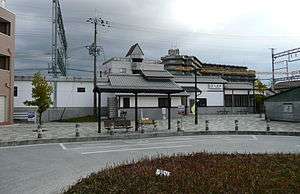Kujō Station (Nara)
Kujō Station 九条駅 | ||||||||||||||||||
|---|---|---|---|---|---|---|---|---|---|---|---|---|---|---|---|---|---|---|
| Kintetsu Railway commuter rail station | ||||||||||||||||||
 The west entrance of Kintetsu Kōriyama Station—May 2007 | ||||||||||||||||||
| Location |
375, Aza-deguchi, Kujochō, Yamato-Koriyama
| |||||||||||||||||
| Coordinates | 34°39′34″N 135°46′59″E / 34.659432°N 135.782972°ECoordinates: 34°39′34″N 135°46′59″E / 34.659432°N 135.782972°E | |||||||||||||||||
| Owned by |
| |||||||||||||||||
| Operated by |
| |||||||||||||||||
| Line(s) | B Kashihara Line | |||||||||||||||||
| Distance | 4.0 km (2.5 mi) | |||||||||||||||||
| Platforms | 2 side platforms | |||||||||||||||||
| Tracks | 2 | |||||||||||||||||
| Train operators |
| |||||||||||||||||
| Bus stands | 1 | |||||||||||||||||
| Connections |
| |||||||||||||||||
| Construction | ||||||||||||||||||
| Structure type | At grade | |||||||||||||||||
| Parking | None | |||||||||||||||||
| Bicycle facilities |
| |||||||||||||||||
| Disabled access | Yes (2 elevators for the ticket gate, 2 elevators for the platforms, and 1 bathroom) | |||||||||||||||||
| Other information | ||||||||||||||||||
| Station code | B29 | |||||||||||||||||
| Website |
www | |||||||||||||||||
| History | ||||||||||||||||||
| Opened | 1 April 1921 | |||||||||||||||||
| Rebuilt | 2002 | |||||||||||||||||
| Traffic | ||||||||||||||||||
| Passengers (2015) | 4,937 daily | |||||||||||||||||
| ||||||||||||||||||
Kujō Station(九条駅) is a railway station in Kintetsu Kashihara Line.
Lines
Platforms and tracks
| 1 | ■ Kashihara Line—Local | for Kashiharajingū-mae and Tenri |
| ■ Kashihara Line—Express | No stops | |
| ■ Kashihara Line—Limited Express | No stops | |
| ■ Kashihara Line—Limited Express Ise-Shima Liner | No stops | |
| ■ Kashihara Line—Limited Express Shimakaze | No stops | |
| 2 | ■ Kashihara Line—Local | for Kyōto, Shin-Tanabe, and Yamato-Saidaiji |
| ■ Kashihara Line—Express | No stops | |
| ■ Kashihara Line—Limited Express | No stops | |
| ■ Kashihara Line—Limited Express Ise-Shima Liner | No stops | |
| ■ Kashihara Line—Limited Express Shimakaze | No stops |
| Kashihara Line | |||||||||||||||||||||||||||||||||||||||||||||||||||||||||||||
|---|---|---|---|---|---|---|---|---|---|---|---|---|---|---|---|---|---|---|---|---|---|---|---|---|---|---|---|---|---|---|---|---|---|---|---|---|---|---|---|---|---|---|---|---|---|---|---|---|---|---|---|---|---|---|---|---|---|---|---|---|---|
Legend
| |||||||||||||||||||||||||||||||||||||||||||||||||||||||||||||
History
- 1921—Kujō Station was opened on the Unebi Line by the Osaka Electric Tramway.
- 1941—It was owned by the Kansai Express Railway that merged with the Sangu Express Railway.
- 2002—The building of the station was rebuilt underground.
- Apr. 1, 2007—PiTaPa, a reusable contactless stored value smart card, has been available.
External links
| Wikimedia Commons has media related to Kujo Station (Nara). |
This article is issued from Wikipedia - version of the 10/2/2016. The text is available under the Creative Commons Attribution/Share Alike but additional terms may apply for the media files.